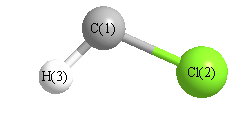Jump to
S2C1
Energy calculated at HF/6-31G
| | hartrees |
|---|
| Energy at 0K | -497.749533 |
| Energy at 298.15K | -497.749347 |
| HF Energy | -497.749533 |
| Nuclear repulsion energy | 36.403491 |
The energy at 298.15K was derived from the energy at 0K
and an integrated heat capacity that used the calculated vibrational frequencies.
Geometric Data calculated at HF/6-31G
Point Group is Cs
Cartesians (Å)
| Atom |
x (Å) |
y (Å) |
z (Å) |
|---|
| C1 |
0.045 |
1.281 |
0.000 |
| Cl2 |
0.045 |
-0.541 |
0.000 |
| H3 |
-1.026 |
1.514 |
0.000 |
Atom - Atom Distances (Å)
| |
C1 |
Cl2 |
H3 |
| C1 | | 1.8220 | 1.0958 |
Cl2 | 1.8220 | | 2.3175 | H3 | 1.0958 | 2.3175 | |
 More geometry information
More geometry information
Calculated Bond Angles
| atom1 |
atom2 |
atom3 |
angle |
|
atom1 |
atom2 |
atom3 |
angle |
| Cl2 |
C1 |
H3 |
102.294 |
|
Electronic energy levels
Charges, Dipole, Quadrupole and Polarizability
Charges from optimized geometry at HF/6-31G
Charges (e)
| Number |
Element |
Mulliken |
CHELPG |
AIM |
ESP |
| 1 |
C |
-0.110 |
|
|
|
| 2 |
Cl |
-0.057 |
|
|
|
| 3 |
H |
0.166 |
|
|
|
Electric dipole moments
Electric dipole components in Debye
(What's a Debye? See section
VII.A.3)
| |
x |
y |
z |
Total |
| |
-1.939 |
0.908 |
0.000 |
2.141 |
| CHELPG |
|
|
|
|
| AIM |
|
|
|
|
| ESP |
|
|
|
|
Electric Quadrupole moment
Quadrupole components in D Å
| Primitive |
|---|
| | x | y | z |
|---|
| x |
-19.889 |
-3.142 |
0.000 |
| y |
-3.142 |
-20.291 |
0.000 |
| z |
0.000 |
0.000 |
-18.348 |
|
| Traceless |
|---|
| | x | y | z |
|---|
| x |
-0.569 |
-3.142 |
0.000 |
| y |
-3.142 |
-1.172 |
0.000 |
| z |
0.000 |
0.000 |
1.741 |
|
| Polar |
|---|
| 3z2-r2 | 3.483 |
|---|
| x2-y2 | 0.402 |
|---|
| xy | -3.142 |
|---|
| xz | 0.000 |
|---|
| yz | 0.000 |
|---|
|
Polarizabilities
Components of the polarizability tensor.
Units are
Å
3 (Angstrom cubed)
Change units.
| |
x |
y |
z |
| x |
1.851 |
-0.425 |
0.000 |
| y |
-0.425 |
4.787 |
0.000 |
| z |
0.000 |
0.000 |
1.597 |
<r2> (average value of r
2) Å
2
| <r2> |
30.399 |
| (<r2>)1/2 |
5.513 |
Jump to
S1C1
Energy calculated at HF/6-31G
| | hartrees |
|---|
| Energy at 0K | -497.785767 |
| Energy at 298.15K | -497.785601 |
| HF Energy | -497.785767 |
| Nuclear repulsion energy | 37.097546 |
The energy at 298.15K was derived from the energy at 0K
and an integrated heat capacity that used the calculated vibrational frequencies.
Geometric Data calculated at HF/6-31G
Point Group is Cs
Cartesians (Å)
| Atom |
x (Å) |
y (Å) |
z (Å) |
|---|
| C1 |
0.037 |
1.225 |
0.000 |
| Cl2 |
0.037 |
-0.540 |
0.000 |
| H3 |
-0.845 |
1.832 |
0.000 |
Atom - Atom Distances (Å)
| |
C1 |
Cl2 |
H3 |
| C1 | | 1.7653 | 1.0704 |
Cl2 | 1.7653 | | 2.5304 | H3 | 1.0704 | 2.5304 | |
 More geometry information
More geometry information
Calculated Bond Angles
| atom1 |
atom2 |
atom3 |
angle |
|
atom1 |
atom2 |
atom3 |
angle |
| Cl2 |
C1 |
H3 |
124.508 |
|
Electronic energy levels
Charges, Dipole, Quadrupole and Polarizability
Charges from optimized geometry at HF/6-31G
Charges (e)
| Number |
Element |
Mulliken |
CHELPG |
AIM |
ESP |
| 1 |
C |
-0.204 |
|
|
|
| 2 |
Cl |
-0.001 |
|
|
|
| 3 |
H |
0.205 |
|
|
|
Electric dipole moments
Electric dipole components in Debye
(What's a Debye? See section
VII.A.3)
| |
x |
y |
z |
Total |
| |
-0.745 |
1.590 |
0.000 |
1.756 |
| CHELPG |
|
|
|
|
| AIM |
|
|
|
|
| ESP |
|
|
|
|
Electric Quadrupole moment
Quadrupole components in D Å
| Primitive |
|---|
| | x | y | z |
|---|
| x |
-18.666 |
-1.359 |
0.000 |
| y |
-1.359 |
-17.094 |
0.000 |
| z |
0.000 |
0.000 |
-19.741 |
|
| Traceless |
|---|
| | x | y | z |
|---|
| x |
-0.248 |
-1.359 |
0.000 |
| y |
-1.359 |
2.109 |
0.000 |
| z |
0.000 |
0.000 |
-1.861 |
|
| Polar |
|---|
| 3z2-r2 | -3.722 |
|---|
| x2-y2 | -1.572 |
|---|
| xy | -1.359 |
|---|
| xz | 0.000 |
|---|
| yz | 0.000 |
|---|
|
Polarizabilities
Components of the polarizability tensor.
Units are
Å
3 (Angstrom cubed)
Change units.
| |
x |
y |
z |
| x |
1.435 |
-0.293 |
0.000 |
| y |
-0.293 |
4.039 |
0.000 |
| z |
0.000 |
0.000 |
1.008 |
<r2> (average value of r
2) Å
2
| <r2> |
29.621 |
| (<r2>)1/2 |
5.443 |
